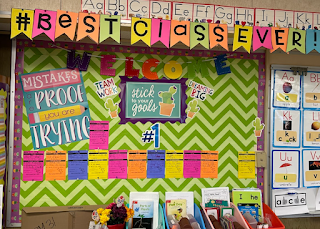1. Students are enthusiastic about working towards their goals. What better motivation than getting a choice as to which areas to want to improve on?
2. Sets a focal point. Students need to funnel down a significant goal into smaller attainable goals. For example, reading can be overwhelming because it involves so many facets- decoding, fluency, comprehension, etc. Having students focus on precise goals makes this duty easier to approach.
3. Increase confidence. Instead of sharing a common goal as everyone else and feeling defeated if they fail, students can make individual goals they can meet.
4. They learn about themselves as a learner. Setting goals can help students learn which habits will make them successful. Students get a chance to find out which practices work best for them and which they feel unsuccessful with as a learner.
5. You can hold them accountable. If a student isn't working hard, you can remind them of the goal they set for themselves and ask them if what they're doing will help them achieve it.
6. They learn life skills. Goal setting, planning, reflecting, and problem-solving are all parts of everyday life, and learning to do these effectively will benefit students throughout their lives.
- Goal-setting sheet: Students write out a goal, as well as how they'll take to get there. This will also include the goal date.
- Post-its: Create an anchor chart for a subject area- reading, for example: Discuss possible areas of improvement and ask questions about which area they can focus on. Students can write their goals on post-it notes and add them to the chart (you can also write for developing writers). It's vital to refer back to this chart to check student growth. You may want to give them a goal sheet to keep as a reminder. This chart can group students by goals and collaborate on ideas to meet their goals.
- Goal Slips: I use these goal slips to help my students set goals to learn High-Frequency words. They choose how many words they will know by a specific date. We brainstorm some ideas of how they can get there: study their word rings for 5 minutes a day, work in a small group with me to practice, read their word list nighly at home.
Celebrate! When students have achieved their goals, they need to celebrate and be rewarded. Students earn a certificate of recognition, a prize, and a class cheer. Then they can set a new goal.
Data- Also, it's important to remember to keep track of all data to help students reflect.
- Sight words, letters/sounds...
- Fluency scores
- Writing- more details, proper punctuation, adding feeling...
- Reading more books
- Doing their homework every night
- Daily routines
- Math Facts
- Behavior management














No comments:
Post a Comment